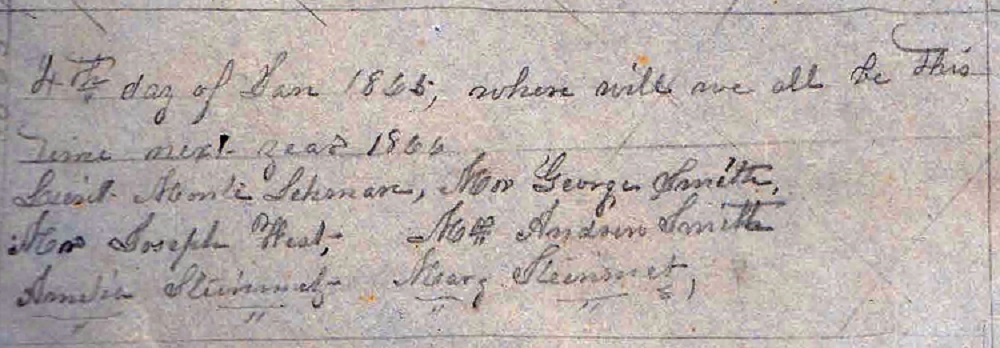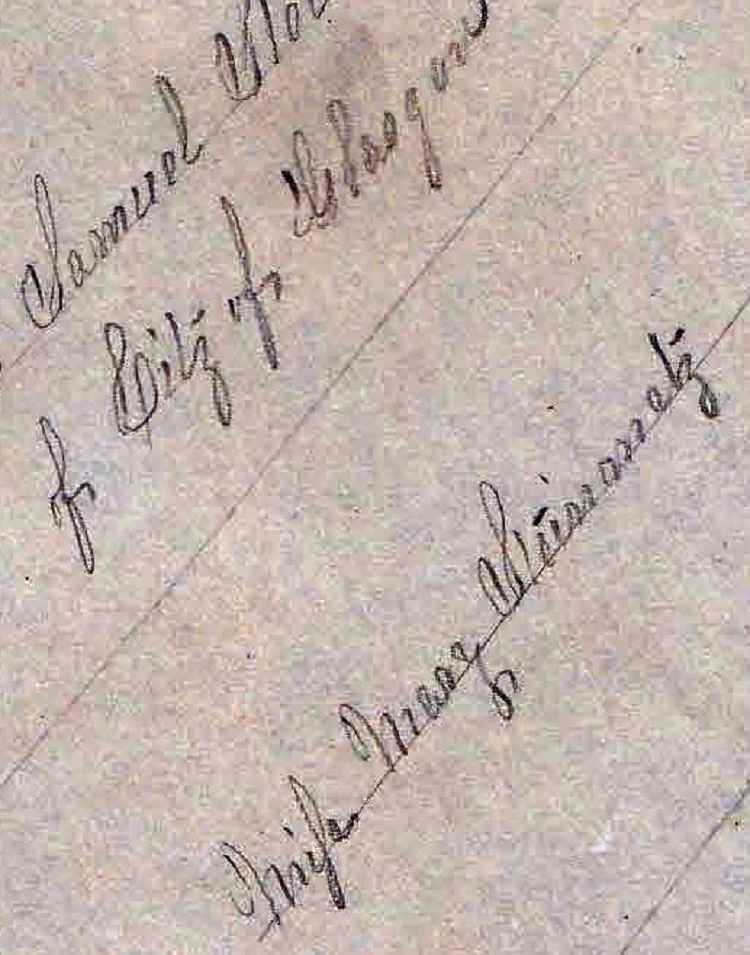PART ONE:
A WELL-OFF, PRESBYTERIAN, TEENAGE GIRL
PART TWO:
MARY'S POLITICS DURING THE CIVIL WAR
PART THREE;
HOW MARY WAS TOUCHED BY THE WAR
PART FOUR:
MARY IDENTIFIED AT LAST
|
 |
The despairing sentence of January 4, 1865: "where will we all be this time next year, 1866?" Mary Steinmetz is the last of the six names. |
In retrospect, I wonder why it took me so long to identify the young, unmarried Glasgow girl who gathered autographs, notes and verses in her album during the Civil War. Her full name was written twice on the very first page.
What threw me off is that Mary did not set her own name apart from the others, just recorded it as any other of the seventeen names on the page, as if the writer were somebody else. All the names are in pencil, similar in size, in small, dainty script. One or two look like autographs. The rest are in the same handwriting, presumably Mary’s.
The names are not in a list, instead sprinkled across the page at different angles. You turn the book sideways to read most of them. Most are framed with boxes, as if old-fashioned visiting cards had been scattered on a sheet of paper and then photocopied.
Here are the first eleven names: Miss Amelia Steinmetz of Glasgow, Mo.; Mr. Samuel Steinmetz; Master Samuel Steinmetz of City of Glasgow; Miss Mary Steinmetz; Master Edward Steinmetz; Master George Steinmetz; Master Aaron Steinmetz of Glasgow, Mo.; Master John Steinmetz of Glasgow, Mo.; Mrs. Lezzetta Steinmetz of Glasgow; Miss Mattie Steinmetz, Sept. 22nd, 1864; J. B. West, Glasgow, Mo., January 4, 1865.
The remaining six names are in a separate box at the bottom, beneath the only text on the page, a single despairing sentence: “4th day of Jan. 1865, where will all be this time next year, 1866?” These names are: Lieut. Monte Lehman, Mr. George Smith, Mr. Joseph West, Mr. Andrew Smith, Amelia Steinmetz, Mary Steinmetz.
The last-named, I conclude, was the Mary who owned the album, the one to whom messages are addressed in later pages. Born in 1845, Mary Steinmetz was an unmarried 18-year-old in 1863, when the entries in the album begin.
From online sources we learn that the names Mary recorded on her album’s first page, besides her own, were those of her parents and siblings. Her father was Mr. Samuel (1809-1895), her mother Mrs. Lezzetta (1825-1903). Miss Amelia and Master Samuel were her older sister and brother. Her younger brothers were Master Aaron, Master Edward, Master George, and Master John.
Mary had one younger sister when this first page of the album was written. Her name was Catherine, born in 1859. This name does not appear. Neither, of course, do the names of three siblings born after the war, Donella, William and Manning. I do not know who “Miss Mattie” was.
As to why Joseph West’s name was on that first page, perhaps it was Mary’s hope at the time that he would become part of the family. On the other hand, in the 1865 addendum, three additional young men are listed. George Smith and Monte Lehman were in the same Company H of the 9th Missouri State Militia. Mary may have had many admirers.
Knowing Mary Steinmetz’s full name makes the other pieces of the puzzle fall into place.
Her family indeed had money enough that a teenaged daughter could appropriately own an expensive album.
A posthumous biography of her father Samuel was published in a 1919 History of Cooper County. It says he was an immigrant from Germany, had gotten rich trading and raising livestock, and was a major breeder of shorthorn cattle. When the Chicago & Alton was extended to Glasgow in 1878, Steinmetz gave the railroad some land from his large farm five miles east of town, on condition that two trains should stop there daily, one going east, the other west. A small village named Steinmetz grew up around the depot, with post office, school, store, and several homes. Samuel’s hobby was horticulture. New varieties of green and black dahlias from his greenhouse won him national acclaim.
Mary’s ethnicity is consistent with her ties to Union soldiers. Overwhelmingly, Missouri’s German population supported the Union during the Civil War.
At first I doubted that the Mary who owned this album was Captain Samuel Steinmetz’s sister, because she refers to him formally, by his military title and rank. I see now that for the young woman, it was a way of acknowledging with respect the important role her older brother was playing in the life-and-death drama of the war.
Knowing who Mary was makes her horror and despair over the bloodshed understandable. The fighting could not have hit closer to home. It was her own flesh and blood, Master Samuel and Master Aaron, her older and younger brothers, who died in the Battle of Glasgow.
As for what became of Mary Steinmetz after the war, an undated autograph near the end of her album tells the tale. It reads simply, “W. A. Meyer.” Seven years older than Mary, he was, like her, offspring of a German immigrant. Like her brothers Samuel and Aaron, also like Monte Lehman and Andrew Smith, William Meyer was a veteran of Company H, 9th Missouri State Militia.
On February 22, 1866, Mary Caroline Steinmetz and William A. Meyer were wed. Their marriage answered the question Mary had written in her album one year before, “Where will we all be this time next year, 1866?”
Mary’s husband became a leading Glasgow businessman. The two-story Italianate building that housed his store, built in 1879, still stands at 605 First Street. On the original front of the building, the side facing the river, you can still make out the oversize lettering: “W. A. MEYER, GROCERIES.”
Mary and William had six children. Two of them, Samuel and Aaron, memorialized her slain brothers. Daughter Lizetta must have been named for Mary’s mother. They named one son William, for his father, and another George, for Mary’s brother. The youngest child, Margaret, became especially well known in the Glasgow community as the wife of W. B. Kitchen, a legendary doctor who practiced here from 1911 until his death in 1947.
Mary and William were both long lived. William died in 1931, at the age of 93. Mary died in 1935, just short of her ninetieth birthday. Like many members of the Steinmetz family, they are buried in Washington Cemetery.
So now you know who Mary was. A young woman’s tattered album, a puzzling artifact of the Civil War, at last makes sense – thanks in great part to historical resources now available online.
Mary undoubtedly treasured her album as long as she lived. By whom and where it should be treasured now, a century and a half after she first set her hand to it, I leave up to the editor and readers of The Glasgow Missourian.
POSTSCRIPT: WHERE THE ALBUM IS NOW
When renovations undertaken in 2016 are complete, the Glasgow Community Museum will become the permanent repository of Mary Steinmetz's album. Until then, the album finds a temporary home at Lewis Library. Thanks to Michael Heying, editor of The Glasgow Missourian, for making these arrangements.
Click here to see photos and detailed genealogical information about Mary Caroline Steinmetz Meyer.
